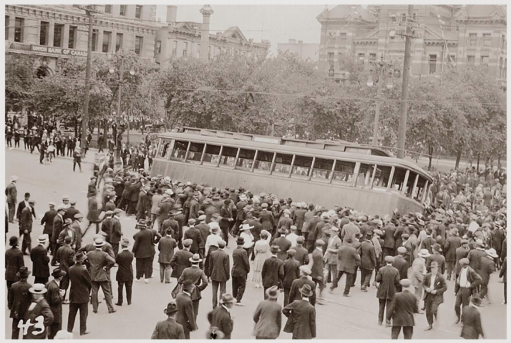
World War One radicalized workers across the world. While workers and farmers in uniform perished and workers and farmers on the home front worked long hours for pay reduced by inflation, munitions manufacturers and food processors made huge profits. After the war, governments led by industrialists and aristocrats rejected both conversion of wartime industry to peacetime purposes and provision of social programs to tide workers over until they could find employment. There were worker uprisings almost everywhere to protest ruling class callousness and to demand workers’ governments and socialist programs.
In Canada, workers used general sympathy strikes on various occasions during World War I to force employers to provide some social justice to workers. In September 1918, for example, after the federal government announced back-to-work legislation for Calgary freight handlers, half the city’s unionized workers obeyed a call for a sympathy strike from the Trades and Labour Council. The federal government quickly made concessions to the freight handlers. In October, Edmonton’s Trades and Labour Council ensured a settlement for Canadian Brotherhood of Railway Employees’ members by endorsing a sympathy strike.
After the war, faced with employer intransigence, Canadian workers joined the worldwide revolt against unreformed capitalism by making the general strike a weapon in the effort to create better conditions for working people in the short term, often with a vision of the long term in which workers would become their own employers and a separate employing class would no longer exist. The One Big Union, which the Western Labour Conference of March 1919 decided to create, was a union movement devoted to such root-and-branch opposition to the subordination of workers to profiteers. Employer resistance to dealing with unions led to metal and construction trades in Winnipeg announcing a strike and asking other unions and non-unionized workers to join them. On May 15, about 35,000 Winnipeg working women and men, two thirds of them non-unionized, stopped work in the hope that worker solidarity would produce the right to unionize for all workers.
Workers across Canada supported the Winnipeg strikers, who faced serious military intervention and jailings during their six week strike. In some cities unionized workers joined the Winnipeg workers on strike in hopes of strengthening the union cause in their city. Calgary and Edmonton had month-long strikes. Meanwhile miners in 42 mines across Alberta struck for two months in sympathy with BC miners who were getting short hours. While general strikes were defeated by state repression, state and employer fears of more worker rebellion resulted in at least some reforms and workers’ memories of the great labour revolt fueled labour resistance in later years when it became clear that the capitalist system remained unreformed and unresponsive to workers’ needs.
